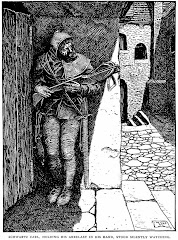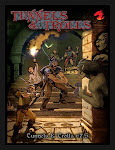 Note: In my discussion in this post and later posts on the Evolution of T&T, I will be discussing the rules as written in the published rulebooks. Of course, the final rule in T&T is "if you don't like it, change it," so there have always been house rules.
Note: In my discussion in this post and later posts on the Evolution of T&T, I will be discussing the rules as written in the published rulebooks. Of course, the final rule in T&T is "if you don't like it, change it," so there have always been house rules.I've always played humans in
Tunnels and Trolls. It's not that I have anything against dwarves, hobbits, leprechauns, fairies, or even elves (well, maybe elves). It's just that I've always felt that humans were more likely to be the ones crawling around tunnels and old ruins in search of wealth and an early grave. But, like in any other fantasy role-playing game, players do have the option of playing nonhuman characters of several different types. In
T&T you may play any kindred you like; and I mean any. Goblins, orcs, gremlins, trolls, giants, minotaurs, and more are all fair game depending on your GM (or yourself if you're playing solo). Many of these monstrous characters are listed in the 5th edition rules and by the 7th edition there is a list of 32 different monster characters to choose from including dragons and living statues. My focus will be on the main five nonhuman kindred, however: elves, dwarves, hobbits (or hobbs), leprechauns, and fairies.
When looking through the different editions of the
T&T rules, it's interesting to see how these main five nonhuman kindreds have been presented each time. The most obvious way to quantify difference between kindreds is to provide attribute modifiers. What I find most interesting is that these modifiers have changed three times on the road from 1st to 7th editions.
Here are the attribute modifiers for the major humanoid kindred:
1st though 4th Editions
.....................ST.....IQ.....DX.....LK.....CON.....CHR
Elf.................1.......3/2....3/2.....3/2....1..........2
Dwarf............2.......1.......1.........1........2..........1
Hobbit..........1/2.....1.......3/2.....1........2..........1
Leprechaun...1/2.....1.......1.........1........1/2.......1
Fairy.............1/4.....1.......1.........1........1...........2
5th Edition
.....................ST.....IQ.....DX.....LK.....CON.....CHR
Elf.................1.......3/2....3/2.....1.......2/3........2
Dwarf.............2.......1.......1.........1........2..........2/3
Hobbit...........1/2.....1.......3/2.....1........2..........1
Leprechaun.....1/2....3/2....3/2.....3/2.....1..........1
Fairy.............1/4......1......3/2.....3/2.....1/4.......2
7th Edition
.............ST....IQ....DX....LK....CON...CHR...WIZ
Elf..........1.....3/2...1.....3/2...2/3...2.....2
Dwarf........2.....1.....1.....2/3...2.....1.....1
Hobbit.......1/2...1.....3/2...3/2...2.....1.....1
Leprechaun...1/2...3/2...3/2...3/2...1.....1.....1
Fairy........1/4...1.....2.....2.....1/4...2.....2
Kindreds can also be given special abilities that make them stand apart from humans. No special abilities are given in 1st or 4th editions with the exception of flight in fairies (in the small ones anyway). In the 5th edition, however, there are special abilities that are mentioned for each of the kindred. These abilities are not quantified in any way, but instead are presented in a mysterious manner almost as if they are rumors and legends. Here is an example:
"The pointy-eared Elves might be able to hear just a little better than a Human, but rumors that they can see to the farthest horizon, or see in the dark are entirely unfounded."
This method of presenting special abilities leaves the details of each of the abilities up to the discretion of the game master. What I like most is that none of kindred can see in the dark unlike other games. This puts all characters on an equal footing when underground or inside a windowless, ancient ruin.
Here is a summary of the kindred abilities in 5th edition:
Elf: Better hearing than humans
Dwarf: Able to appraise jewels and gems on sight
Hobbit: Good at stealth and hiding
Leprechaun: Can only be Wizard, but start with no spells other than a modified Wink-Wing
Fairy: The power of flight (Does that do anything for you?)
In 7th edition, the restriction of Leprechauns to wizards is listed as well as their starting use of a Wink-wing ability, but their lack of 1st level spells in not included. No other kindred abilities are mentioned.
As you can see, the five major nonhuman kindred have changed considerably over the last 30 years. There is certainly nothing wrong with that; rules like organisms, should change over time. In most cases I think the goal of the change was balance (of course I could be wrong).
The most striking aspect of the different nonhuman kindreds in 1st - 4th edition rules is the imbalance of their attribute modifiers. At their inception, elves were the uber-kindred of T&T. Four (intelligence, dexterity, luck, AND charisma) of their six attributes were increased from the initial roll and none were reduced. This made elves the default kindred of choice for the aspiring delver because they had no weaknesses (except for being snooty elves). Dwarves were similarly imbalanced having their strength and constitution doubled with no other attribute reduced. Dwarves were stronger and heartier than any other character option, capable of dealing more damage and taking more punishment than the other kindreds with no drawbacks (well, they were short). Leprechauns were just the opposite of dwarves; their strength and constitution were both halved with no benefit of any sort. One wonders if anyone ever elected to play a leprechaun and if they did, why? Hobbits and fairies were the two most balanced nonhuman kindreds and I think they set the stage for later development of kindreds in the following editions. Both featured attributes that were raised and others that were lowered. Hobbits enjoyed increased dexterity (x3/2) and constitution (x2) with the loss of half their rolled strength. Fairies had charisma doubled, but only a quarter of their rolled strength. They did have the ability to fly, but only with a strength of 2 or less. Any higher and they were considered too heavy to get off of the ground.
In the 5th edition rules, all kindreds acquired both positive and negative modifier to their attributes. In fact, in some cases the attributes that were modified changed from those in 1st and 4th edition. Elves retained their increased intelligence, dexterity, and charisma, but lost the increase to their luck. I've wondered why were elves considered luckier in the first place. In addition, the mighty elves were given a disadvantage (gasp!). Elves constitution was reduced to 2/3 of the rolled value. They might have been quicker, smarter, and prettier than mere humans, but at least they were now easier to kill. Dwarves kept their doubled strength and constitution, but suffered a reduced charisma. Given that charisma is generally considered a 'dump stat,' I doubt this reduced the number of dwarf warriors out there. Of course, a charisma saving roll can also spell the difference between life and death. Dwarves, typically thought of as miners, gained the ability to determine the value of gems and jewels on sight. Quite a handy ability once you try to sell your plundered valuables. Leprechauns were given new life in 5th edition. The changes are actually highlighted in the rules and the statement is made:
"We hope more players will find the new Leprechauns of sufficient interest to insure their presence in dungeons everywhere." In 5th edition, only the strength of leprechauns is halved. They also gained bonuses (x1.5) to their intelligence, dexterity, and luck. That was quite a change. Tempering these boosts in attributes is their restriction to the wizard type but with no starting 1st level spells with the exception of a
Wink-Wing equivalent (short range teleportation, normally a 4th level spell). In comparison, wizards of every other kindred start with the knowledge of ten first level spells. Fairies received a similar level of overhaul; their strength and charisma modifiers remained the same, but they received boosts to their dexterity and luck (x1.5) as well as a large reduction (x.25) in constitution (to be expected in such a small creature). The restriction that fairies with a strength greater than 2 could not fly was also removed. The reason given for this change was that a fairy's ability to fly was magical in nature and not restricted by physics. Hobbits, being hobbits, remained unchanged. They were already the most balanced nonhuman kindred in the game so there was no need to alter them although they did gain their mysterious abilities to sneak and hide (tricksy hobbits).
Kindred experienced another pulse of evolutionary change with the release of the 7th edition rules. Elves, never ones to left out, lost their increased dexterity but regained their increased luck and doubled their magical energy with the official addition of the Wizardry attribute. Why the switch from increased dexterity to increased luck? No idea, elves are mysterious. Dwarves also experienced a shift in their attributes; their charisma was no longer reduced (did they start showering and shaving?) but instead their luck was reduced. This change is a rather significant one because it reduces the number of personal adds, the T&T quantification of fighting prowess, of the standard tough dwarf warrior. Hobbits, a species that experienced no change since their appearance in 1st edition, gained increased luck. They also received a new name: Hobbs. Oh well, they'll always be hobbits to me. Fairies once again were increased in their attributes making them even more viable as characters; in particular wizards. The dexterity and luck modifiers of fairies were increased to x2 and the new Wizardry attribute was given a x2 modifier. The major problem with fairies before this was that their low strength made them poor fighters AND wizards because strength was needed to power magic as well a provide personal adds. With a doubled wizardry attribute now powering a fairies spells, and doubled dexterity and luck providing personal adds to make up for lost strength, these become very potent characters. The attributes of leprechauns remained unchanged from 5th edition. As I mentioned previously, there is little to no mention of special abilities of the different kindred in 7th edition. This aspect of kindred appears to have been left entirely up to the game master and player. The exception is for leprechauns who are still restricted to the wizard type and have a natural
Wink Wing ability. Their lack of starting first level spells, however, is not mentioned making leprechauns much more appealing as characters.
Just as an example, I rolled up a character and assigned the rolls to attributes in order. I included Wizardry from the 7th edition rules, but left out Speed to keep Personal Adds modifiers constant. Here is the human version:
ST 11...IQ 15...LK 7...DX 11...CON 16...CHR 9...WIZ 14...ADDS: -2
Not too bad. A rather unlucky, but healthy wizard perhaps. His low dexterity will prevent him from casting higher level spells, but he can work to improve his finger-work with some practice; if he survives.
Let's see this same character as an elf through the different editions:
1st/4th..ST 11...IQ 23...LK 11...DX 17...CON 16...CHR 18...ADDS: +5
5th.......ST 11...IQ 23...LK 7....DX 17...CON 11...CHR 18...ADDS: +3
7th.......ST 11...IQ 23...LK 11...DX 12...CON 11...CHR 18...WIZ 28...ADDS: +0
There's no question that in 1st and 4th editions the elf is somewhat over-the-top. I imagine most adventuring parties were composed of a large number of elves. In 5th and 7th editions, this is tempered somewhat by the reduction of CON; but with a good starting roll it is not a great disadvantage, especially with the addition of the WIZ attribute in 7th edition which is doubled. There's also the fact that in 7th edition your starting level is dependent on you attributes (a topic for another post). So the majority of elf characters will always start at a minimum of 2nd level providing added bonuses.
Now here's the dwarf:
1st/4th..ST 22...IQ 15...LK 7...DX 11...CON 32...CHR 9...ADDS: +8
5th......ST 22...IQ 15...LK 7...DX 11...CON 32...CHR 6...ADDS: +8
7th......ST 22...IQ 15...LK 5...DX 11...CON 32...CHR 9...WIZ 14...ADDS: +6
This makes a pretty solid warrior regardless of edition, and in particular in 1st/4th editions. In 5th edition he's a bit unlikeable and would certainly not be leading any negotiations you'd want to succeed. I wouldn't want to stand near the 7th edition dwarf in a thunder storm; this character also highlights the fact that the negative modifier on luck can reduce the combat effectiveness of the dwarf to counterbalance their extremely high strength. The presence of a 2x modifier in two attributes also guarantees that most dwarf characters (Citizens, Specialists, Warriors, and Paragons) will start at level 2 in 7th edition.
The sneaky hobbit:
1st/4th..ST 6....IQ 15...LK 7...DX 17...CON 32...CHR 9...ADDS: +0
5th......ST 6....IQ 15...LK 7...DX 17...CON 32...CHR 9...ADDS: +0
7th......ST 6....IQ 15...LK 11..DX 17...CON 32...CHR 9...WIZ 14...ADDS: +2
As I've mentioned, the hobbit started with a good balance of positive and negative modifiers. His high constitution makes an armored hobbit almost unkillable (almost). With the addition of increased luck in 7th edition, hobbits are even more potent characters as this easily offsets their reduced strength when paired with their already heightened dexterity.
The misunderstood leprechaun:
1st/4th..ST 6....IQ 15...LK 7...DX 11...CON 8....CHR 9...ADDS: -5
5th......ST 6....IQ 23...LK 11..DX 17...CON 16...CHR 9...ADDS: +2
7th......ST 6....IQ 23...LK 11..DX 17...CON 16...CHR 9...WIZ 14...ADDS: +2
Again, why would anyone play a leprechaun in 1st and 4th edition? By the 5th edition, however, leprechauns make very effective wizards with heightened intelligence, dexterity, and luck as well as a constitution equivalent to humans. With these changes I'm sure their numbers swelled the ranks of adventuring parties everywhere. The addition of the wizardry attribute in 7th edition also helps them overcome their reduced strength and maximizes their spell-casting abilities.
Finally the fairy:
1st/4th..ST 3....IQ 15...LK 7...DX 11...CON 16...CHR 18..ADDS: -8
5th......ST 3....IQ 15...LK 11..DX 17...CON 4....CHR 18..ADDS: -1
7th......ST 3....IQ 15...LK 14..DX 22...CON 4....CHR 18..WIZ 28...ADDS: +7
The 1st/4th edition fairy is very disappointing. Sure he's pretty, but being musclebound for a fairy with a ST of 3, he can't even fly. The fairy improves considerably in 5th edition; the increased luck and dexterity significantly increases his personal adds (although they're still negative) even though his constitution has been quartered. But by 7th edition we have a formidable wizard or rogue on our hands; a flying platform hurling TTYFs over the heads of his larger comrades and into the ranks of goblins, frogmen, or zombies.
So as you can see, the five major nonhuman kindred have changed considerably from 1st to 7th editions of
T&T. While many of these changes might be considered minor, I think the examples I presented above illustrate how significant they really are to the game. Having analyzed these kindred in such detail, I may stop playing humans. My next 7th edition character may just be a leprechaun.
 My thanks to Scott Malthouse of Trollish Delver for his latest post on Fighting Fantasy. I had not been to the Fighting Fantasy website or even known of its existence until now. The amount of content on the website, including fan-produced material, is impressive. I bought and played a number of these books published by Dell in the 1980s; the first one I acquired was Deathtrap Dungeon and is still the one that stands out in my mind as the best. The cover of that edition by Richard Corben (shown to the right) was also one of my favorites in the series. The Baron is especially creepy and devious-looking in this portrayal. My collection of these books is long gone but not their influence.
My thanks to Scott Malthouse of Trollish Delver for his latest post on Fighting Fantasy. I had not been to the Fighting Fantasy website or even known of its existence until now. The amount of content on the website, including fan-produced material, is impressive. I bought and played a number of these books published by Dell in the 1980s; the first one I acquired was Deathtrap Dungeon and is still the one that stands out in my mind as the best. The cover of that edition by Richard Corben (shown to the right) was also one of my favorites in the series. The Baron is especially creepy and devious-looking in this portrayal. My collection of these books is long gone but not their influence.














